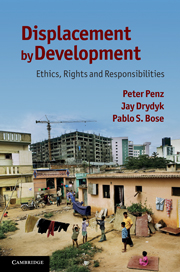PART IV - REALIZING RESPONSIBILITIES
Published online by Cambridge University Press: 05 June 2012
Summary
Part IV moves our discussion of development ethics out of the realms of theory and policy and begins to examine what it might mean in practice when considering displacement by development. Earlier sections of the book have outlined multiple facets of the development and displacement dynamic – from the charged positions held by various stakeholders, through the central ethical dilemmas that affect both processes and outcomes, to the institutional impediments and constraints on imagining different possibilities. In our final two chapters, we take up the development ethics framework to look more closely at the ways in which tangible and practical interventions may be made in the convoluted dynamics of development, whether at the local, national, or international scales. Chapter 11 focuses on the well-known case of the Narmada Valley Development Projects, a massive hydro-electric scheme to build dams in central and western India. While this book has gone to some length to provide examples that extend the lens on development and displacement, the Narmada case remains an instructive one in our understanding of these processes, especially as multi-scalar and complex dynamics. We apply to this familiar context the development ethics framework as both an analytic and a proscriptive tool, asking what tools a focus on the values we have identified may provide us with in terms of identifying ethical wrong-doing and showing a guide to better practices in the future.
- Type
- Chapter
- Information
- Displacement by DevelopmentEthics, Rights and Responsibilities, pp. 261 - 262Publisher: Cambridge University PressPrint publication year: 2011



